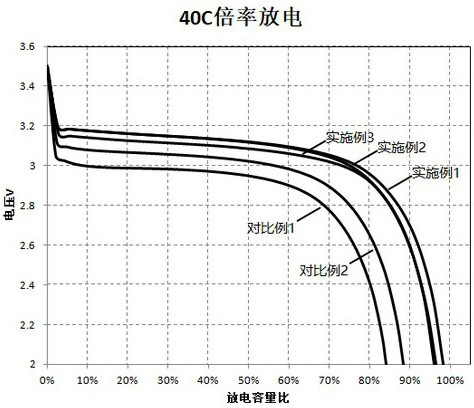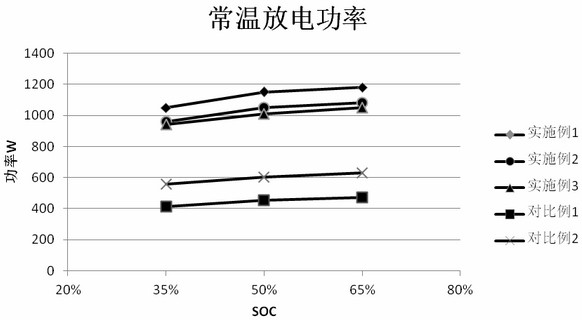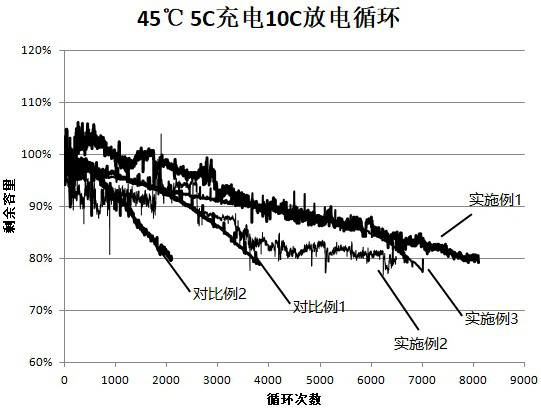High-power lithium ion battery for automobile start-stop power supply
A lithium-ion battery, high-power technology, applied in battery electrodes, secondary batteries, circuits, etc., can solve problems such as the inability of vehicles to recover braking energy, the inability of batteries to be charged with high power, and the reduction of fuel-saving effects, so as to improve battery performance. Current capacity, structural stability, and the effect of improving electrical conductivity
- Summary
- Abstract
- Description
- Claims
- Application Information
AI Technical Summary
Problems solved by technology
Method used
Image
Examples
Embodiment 1
[0051] A kind of high-power lithium-ion battery of the automobile start-stop power supply of the present embodiment, as Figure 4 Shown: including positive electrode sheet, negative electrode sheet, positive electrode ear 3, negative electrode ear 1, separator, electrolyte and battery case. The positive electrode sheet includes a positive electrode current collector, a conductive coating coated on the positive electrode current collector, and a positive active material layer coated on the surface of the positive electrode current collector conductive coating: the negative electrode sheet includes a negative electrode current collector and is coated on the negative electrode. The negative electrode active material layer on the surface of the current collector, the positive electrode sheet and the negative electrode sheet form the battery 2, and the battery 2 is placed in the battery casing, and the positive electrode ear 3 and the negative electrode ear 1 protrude from both ends...
Embodiment 2
[0075] The present invention includes positive electrode sheet, negative electrode sheet, positive electrode ear 3, negative electrode ear 1, separator, electrolyte and battery case. The positive electrode sheet includes a positive electrode current collector, a conductive coating coated on the positive electrode current collector, and a positive electrode active material layer coated on the surface of the positive electrode current collector. In terms of mass percentage, the content of the positive electrode active material layer is as follows:
[0076] Lithium iron phosphate 88%;
[0077] Carbon black 5.8%;
[0078] Carbon nanotubes 1.5%;
[0079] Graphene 1.7%;
[0080] Polyvinylidene chloride 3%;
[0081] The particle size D50 of lithium iron phosphate ranges from 0.2 μm to 0.5 μm, and the maximum particle size does not exceed 5 μm; the mass percentage of the carbon coating layer on the surface of lithium iron phosphate particles is 1.5% to 2.5%. The lithium iron phosp...
Embodiment 3
[0095] The product structure of this embodiment is the same as that of Embodiment 1. The difference from Example 1 is that the positive current collector is a conductive coated aluminum foil with a total thickness of 21 μm, wherein the conductive coating is coated on the positive current collector before coating the positive active material, and the conductive coating with a total thickness of 1 μm is conductive. The coating is a mixture of carbon black, carbon nanotubes, graphene and a binder. The mass ratio of carbon black, carbon nanotubes, graphene and binder is: 7.5:0.8:1.5:0.2. All the other preparation methods are the same as in Example 1.
PUM
| Property | Measurement | Unit |
|---|---|---|
| particle diameter | aaaaa | aaaaa |
| particle size | aaaaa | aaaaa |
| width | aaaaa | aaaaa |
Abstract
Description
Claims
Application Information
 Login to View More
Login to View More - R&D
- Intellectual Property
- Life Sciences
- Materials
- Tech Scout
- Unparalleled Data Quality
- Higher Quality Content
- 60% Fewer Hallucinations
Browse by: Latest US Patents, China's latest patents, Technical Efficacy Thesaurus, Application Domain, Technology Topic, Popular Technical Reports.
© 2025 PatSnap. All rights reserved.Legal|Privacy policy|Modern Slavery Act Transparency Statement|Sitemap|About US| Contact US: help@patsnap.com



